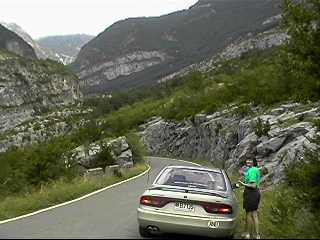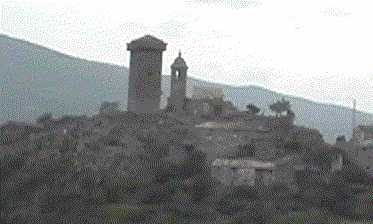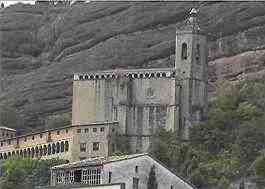A Short Tour of the Pyrenees
|
|
We drove along the Corniche Basque and thought about the other places we have
seen with similar landscapes: the California coast; the Cabot Trail; Newfoundland;
Cabo de S. Vicente, Portugal; Cannes. There is little to compare with a high
windswept cliff beside a sparkling blue sea. We crossed into Spain, passing the deserted customs booths, made redundant by the Treaty of Masstricht. Just over the border, the gas was much cheaper than in France. In France, the price is 50% higher than in Andorra. In Spain it is about 20% more. No wonder there were no gas stations in St-Jean-de-Luz. The only one we did see was in the process of being dismantled. We wound our way south through the Bidasoa Mountains towards Pamplona. The green hills of the northern Pyrenees turned to the dusty dry plains of Spain. No, the rain doesn't fall on the plains in Spain. Pamplona turned out to be a big dull modern city. It is a popular destination in July, when the feria de San Fermín attracts crowds of drinkers to quaff the local brandy all night and, in a crapulous state the next morning, dodge running bulls. But in September, we found it had little to offer in comparison with the beautiful scenery of the mountains. We turned east across the high, dry, desert. Our map shows a green fringe on the road to Jaca, but that is the wrong colour. For the most part the countryside is a reddish orange. Ghost towns rise out of the sand and gravel on ancient mounds. Crumbled church steeples and tattered wooden shutters show that the people have gone somewhere else. We wondered what had drawn them there in the first place. Jaca stands on a high terrace overlooking the Rio Aragon Valley. We found a small, but comfortable hotel, looking down on a huge sports complex. Cheers from the football game in progress rose to our balcony. That was pleasant enough. But then, the sound of a small, unmuffled, lawnmower also rose to our ears. For the next eternity and a half, we closed our doors as a small figure carefully mowed the adjoining football field, stopping only from time to time to fill the tiny gas tank.  On Monday morning the scenery improved as we wound our way along the tiny roads,
up into the mountains, and towards the fabulous Parque Nacional de Ordesa.
This is the Yosemite of Spain. Vast steel gray, layered limestone escarpments rise
1,000 meters above the valley floor, streaked with red ochre strata.
Hiking trails lead off into the steep valleys.
It appears to be a rock climber's paradise, but we saw none on the steep faces
of the cliffs.
The parking lot was full of hikers preparing their packs with tents and sleeping
bags.
On Monday morning the scenery improved as we wound our way along the tiny roads,
up into the mountains, and towards the fabulous Parque Nacional de Ordesa.
This is the Yosemite of Spain. Vast steel gray, layered limestone escarpments rise
1,000 meters above the valley floor, streaked with red ochre strata.
Hiking trails lead off into the steep valleys.
It appears to be a rock climber's paradise, but we saw none on the steep faces
of the cliffs.
The parking lot was full of hikers preparing their packs with tents and sleeping
bags.
 Heading south along the banks of the huge reservoirs, the Embalse de Mediano and the
Embalse de El Grado, the countryside turned dry and sandy again.
We turned off at a sign for Naval and Abizanda promising ceramic artisanal crafts in
1 kilometer. But 6 kilometers later, we found nothing, so we turned back with no more
to show for our excursion than this grainy picture of Abizanda, perched on its
rocky promontory.
Heading south along the banks of the huge reservoirs, the Embalse de Mediano and the
Embalse de El Grado, the countryside turned dry and sandy again.
We turned off at a sign for Naval and Abizanda promising ceramic artisanal crafts in
1 kilometer. But 6 kilometers later, we found nothing, so we turned back with no more
to show for our excursion than this grainy picture of Abizanda, perched on its
rocky promontory.Across the reservoir, the imposing vast brick facade of the Torreciudad cuts into the landscape. Built in 1975, under the auspices of Monsignor Joseé Maria Escrivá de Balaguer, founder of Opus Dei, the church holds the 11th century Romanesque statue of Our Lady of Torreciudad, venerated by the local people since 1804. We crossed the Rio Cinca at the base of the huge dam by El Grado and ascended the vertiginous track to La Pueblo de Castro. Now that we were climbing, the gas gauge descended perilously close to the low end of the scale, and we noted that we had not seen a single gas station in the past four hours of driving.  But Graus was a larger town than we expected, and there on our right was the welcome
green signage of a BP station. Perched above the town, an ancient monastery rises from
the rocks. As at Mont St-Michel, we marvel again at the scale of buildings undertaken
by the monks of the middle ages.
But Graus was a larger town than we expected, and there on our right was the welcome
green signage of a BP station. Perched above the town, an ancient monastery rises from
the rocks. As at Mont St-Michel, we marvel again at the scale of buildings undertaken
by the monks of the middle ages.
|